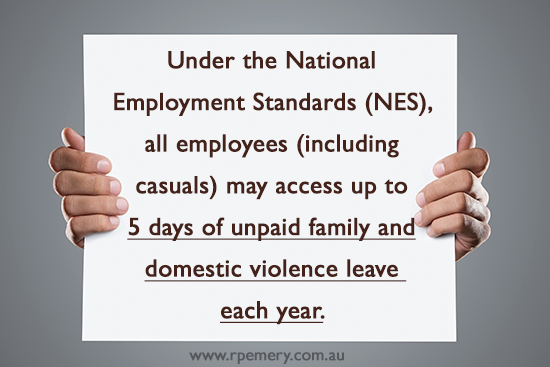Domestic and family violence can take several forms. It may involve physical violence, sexual violence and emotionally abusive, harassing or controlling behaviour [1]. Domestic violence typically refers to violent behaviour between a current or former intimate partner. Family violence extends to violence between family members [2].

The prevalence of domestic and family violence has risen dramatically during the covid 19 pandemic. With people restricted to their homes during government-mandated lockdowns, individuals are isolated and cut off from essential support systems like school or work.
In
a recent survey, 53.1% of woman who had previously experienced physical or sexual violence from their current or former partner reported an increase in its frequency or severity since February 2020 [3].
Domestic and family violence can have far-reaching consequences for Australia’s working population. ABS data reveals that about two-thirds of women who experience domestic violence are members of the workforce [4]. The impact on the economy in lost productivity, absenteeism and staff turnover is therefore significant [5]. As an employer, you should ensure you provide a safe and supportive workplace to assist employees who are experiencing domestic or family violence.
Domestic and family violence leave entitlement under the NES (National Employment Standards)
In late 2018, the Federal Government introduced the domestic and family violence leave entitlement to Australia’s national workplace relations system.
Under the Fair Work Act’s National Employment Standards (NES), all employees (including casuals) may access up to 5 days of unpaid family and domestic violence leave each year. Notably, the entitlement does not accumulate year to year. However, the provisions do not prevent an employee from taking more than five days leave if they can reach an agreement with their employer.

An employee may require this type of leave for a number of reasons. In order to protect themselves from ongoing harm, they may need to relocate as far away from an abuser as possible. Alternatively, the worker may need to attend urgent court hearings, access police services or seek medical attention and counselling.
Recognising the signs of domestic and family abuse is not always an easy task. Section 106B(2) of the Act offers a broad definition of the term, so as to include any “violent, threatening or other abusive behaviour by a close relative of an employee that seeks to coerce or control the employee; and causes the employee harm or to be fearful”.
An employee’s close relative may include various parties, such as a –
• Current or former spouse
• De facto partner or former de facto partner
• Child
• Parent
• Grandparent
• Grandchild
• Sibling
• Person related to the employee according to Aboriginal or Torres Strait Islander kinship rules
The addition of domestic and family violence leave as a minimum entitlement under the NES is important for the purposes of enforcement. An unreasonable refusal to accommodate an worker’s request for domestic and family violence leave may amount to a breach of the NES. This attracts hefty penalties in excess of $13,000 (for an individual) or $66,000 (for a company) [6].
Domestic and family violence is a sensitive topic. Employers are also obliged to take steps to ensure that any information regarding the employee’s leave is treated confidentially, as far as it is reasonably practicable to do so.
Proposed amendments to the existing NES entitlement
Recently, the Federal Government proposed the Fair Work Amendment (Ten Days Paid Domestic and Family Leave) Bill 2020 (the Bill) to improve the existing entitlement in the NES. The amendments seek to expand an employee’s entitlement to domestic and family violence leave in Australia from 5 days of unpaid leave to 10 days of paid leave.
The total amount that an employer must pay an employee who takes a period of domestic and family violence leave will depend on the employee’s classification. Permanent employees (full-time and part-time) are to be paid at their base rate of pay for their ordinary hours of work. Casual employees will be entitled to their base rate of pay, plus an additional casual loading for the hours the employee was rostered during the period they are taking the leave.
As a victim of domestic or family violence, an employee may experience significant financial costs associated with the task of finding alternative housing or accommodation. Therefore, taking a total of 5 days leave will act as a disincentive if it means the employee loses a significant portion of their earnings.
As an alternative, an employee may turn to other forms of paid leave, such as sick leave or annual leave. This eats into the accrued total of leave an employee may wish to use for another purpose, such as a holiday or time spent looking after a sick child. The proposed changes to the existing entitlement thereby recognise that employees experiencing domestic and family violence are deserving of financial support.
Recent data collected by the Workplace Gender Equality Agency reveals a sharp increase in the number of Australian organisations supporting employees who are experiencing family or domestic violence [7]. Roughly 30% of employers already offer paid domestic or family violence leave for impacted employees [8]. The amendments will aim to promote better consistency across the board and align the NES with the best practices of many Australian employers.
Support Services for those impacted by domestic or family violence
If you have been impacted by domestic or family violence, it is important to know that ongoing support is available.
1800 RESPECT is open 24/7 to provide confidential information, counselling and support services to anyone who has experienced or is at risk of domestic and family violence. You can visit their website here.
By Kirra Griffin June 2021
 Kirra Griffin is a final-year law student at Melbourne Law School. As our resident legal assistant, Kirra uses her specialised knowledge of the law to translate complex concepts into easily digestible information.
Kirra Griffin is a final-year law student at Melbourne Law School. As our resident legal assistant, Kirra uses her specialised knowledge of the law to translate complex concepts into easily digestible information.
Other Articles and Resources
What types of employees do you have? Are you meeting your obligations?
 Thanks to an increasingly flexible workplace, it seems like when it comes to employee contracts, almost anything goes. But It’s important to classify your employees correctly so that they receive all their entitlements under the law and you comply with the legislation.
Thanks to an increasingly flexible workplace, it seems like when it comes to employee contracts, almost anything goes. But It’s important to classify your employees correctly so that they receive all their entitlements under the law and you comply with the legislation.
Streamline the process of employing new staff by using Employment Contract Templates
 Employment Contracts are ideal discussion points to be referred to when interviewing, recruiting and hiring staff. As the contracts cover the essentials, by working your way through the contract you can make sure you are not missing anything important.
Employment Contracts are ideal discussion points to be referred to when interviewing, recruiting and hiring staff. As the contracts cover the essentials, by working your way through the contract you can make sure you are not missing anything important.

